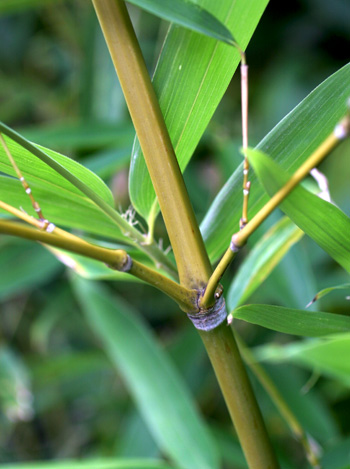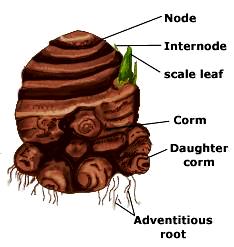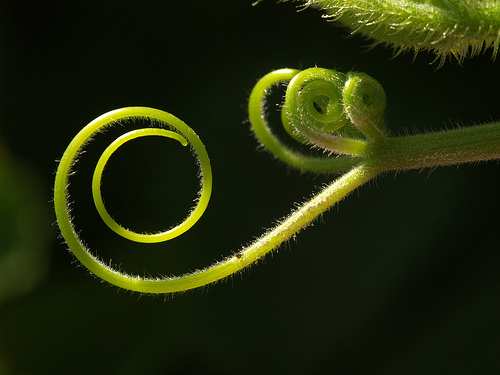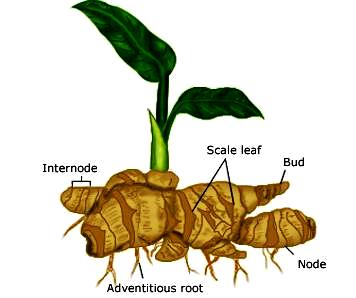Stem
Table of Content |
 -
- The stem develop from the plumule of the germinating seed.
The stem develop from the plumule of the germinating seed.
- Normally it is the aerial part of the plant body. The stem with its branches, leaves, buds, flower and appandages is known as Shoot System.
- The stem shows the differentiation of nodes and internodes.
- The place where the leaf develops on the stem is called the node.
- The portion of the stem between two successive nodes is called the internode.
Characteristics of Stem
(i) Stem is an ascending axis of the plant and develops from the plumule and epicotyl of the embryo.
(ii) It is generally erect and grows away from the soil towards light. Therefore, it is negatively geotropic and positively phototropic.
(iii) The growing apex of stem bears a terminal bud for growth in length.
(iv) In flowering plants, stem is differentiated into nodes and internodes. A node occurs where leaves are attached to the stem. Internode is the portion of stem between the two nodes.
(v) The lateral organs of stem (i.e., leaves and branches) are exogenous in origin (from cortical region).
(vi) The young stem is green and photosynthetic.
(vii) Hair, if present, are generally multicellular.
(viii) In mature plants, stem and its branches bear flowers and fruits.
Diverse forms of Stem
 (i) Reduced stems : In some plants, the stem is in the form of a reduced small disc which is not differentiated into nodes and internodes. e.g., (a) A reduced green-coloured disc-like stem lies just above the base of fleshy roots of Radish, Carrot and Turnip ; (b) Green-coloured small discoid stem occurs in free-floating Lemna, Spirodela and Wolffia; (c) Highly reduced non-green discoid stem occurs at the base of Onion and Garlic bulbs, etc.
(i) Reduced stems : In some plants, the stem is in the form of a reduced small disc which is not differentiated into nodes and internodes. e.g., (a) A reduced green-coloured disc-like stem lies just above the base of fleshy roots of Radish, Carrot and Turnip ; (b) Green-coloured small discoid stem occurs in free-floating Lemna, Spirodela and Wolffia; (c) Highly reduced non-green discoid stem occurs at the base of Onion and Garlic bulbs, etc.
(ii) Erect stems : Majority of angiosperms possess upright, growing-ascending, vertically-erect stems. They are fixed in the soil with the help of roots. Erect stems belong to four categories :
(a) Culm : Erect stems with solid nodes and hollow internodes. The nodes are swollen giving the stem a jointed appearance e.g., Bamboo (Bambusa arundinacea) and wheat (Triticum vulgare).
(b) Caudex : The main stem remains unbranched and bears a crown of leaves at its top. e.g., Coconut (Cocos nucifera), Palm, etc.
(c) Excurrent : The main stem is trunk like. It is thickest at the base and gradually tapers towards the apex. The branches arise in acropetal succession, i.e., oldest at the base and youngest at the apex. The tree appears cone-shaped. e.g., Casuarina, Eucalyptus, etc.
 (d) Decurrent or Deliquescent : The apical bud of main stem is weak as compared to the buds of lateral branches. Thus, the lateral branches are prominent and spreading. The main stem grows upto a certain height after which it gives several branches. These branches dominate by giving the branches of several orders. The whole tree looks like dome-shaped. e.g., Banyan (Ficus bengalensis).
(d) Decurrent or Deliquescent : The apical bud of main stem is weak as compared to the buds of lateral branches. Thus, the lateral branches are prominent and spreading. The main stem grows upto a certain height after which it gives several branches. These branches dominate by giving the branches of several orders. The whole tree looks like dome-shaped. e.g., Banyan (Ficus bengalensis).
(iii) Weak stems : They are thin, soft and delicate which are unable to remains upright without any external support. They are of two types : upright weak stems and prostrate weak stems.
(a) Upright weak stem
-
Twiners : The stems are long, slender, flexible and very sensitive. They twin or coil around an upright support on coming in its contact due to a special type of growth movement called nutation. They may coil the support to the right (anticlockwise from the top or sinistrorse) e.g., Convolvulus sp., Ipomoea quamoclit Clitoria ternatea, etc. or to the left (clockwise or dextrorse), e.g. Lablab.
-
Climbers : The stem is weak and unable to coil around a support. They usually climb up the support with the help of some clasping or clinging structure. They are of four types :
 (i) Tendril climbers : Tendrils are thread like structure which help in climbing the plants. They may be modified stem (e.g., Vitis), stem branches (e.g., Passiflora) and inflorescence (e.g., Antigonon).
(i) Tendril climbers : Tendrils are thread like structure which help in climbing the plants. They may be modified stem (e.g., Vitis), stem branches (e.g., Passiflora) and inflorescence (e.g., Antigonon).
(ii) Root climbers : Adventitious roots arise from the nodes and penetrate into the upright support so that the climber climbs up,e.g., Betel vine (Piper betel), Tecoma, Ivy, etc.
(iii) Scramblers or Hook climbers : These weak stemmed plants slowly grow over other bushes and rest there. They attain this position with the help of curved prickles (e.g., Rose), curved hooks on flowering peduncle (e.g., Artabotrys), prickles on stem (e.g., Lantana), spines (e.g., Climbing Asparagus) or spinous stipules (e.g., Zizyphus).
(iv) Lianas : These are woody perennial climbers found in deep forests. At first, they are just like ordinary twiners but once they reach to the top and get sunlight, become woody. e.g., Tinospora, Ficus, Bauhinia, Bignonia, etc.
(b) Prostrate weak stem
-
Trailers : The stem creep on the ground but roots do not arise at the nodes. They are of three types :
(i) Procumbent : The stem creeps on the ground totally e.g., Tribulus, Bassela, Evolvulus.
(ii) Decumbent : Branches, after growing horizontally for some length, grow vertically upwards, e.g., Portulaca, Tridax, Lindenbergia, etc.
(iii) Diffuse : Branches grow profusely in all directions, e.g., Boerhaavia.
-
Creepers : These weak-stemmed plants grow prostrate and develop adventitious roots from their nodes. Creepers are of three kinds – runners, stolons and offsets.
(i) Runners : This prostrate aerial stem has a long internode and creeps horizontally. Axillary buds arise from nodes to form aerial shoots and roots. Several small (daughter) plants are thus linked by runner which may break off later. e.g., Cynodon (doob grass) and Oxalis.
(ii) Stolons : They are special kinds of runners which initially grow upwards like ordinary branches and then arch down to develop new daughter plants on coming in contact with the soil. e.g., Strawberry (Fragaria vesica), Peppermint (Mentha piperita), Jasminum (Jasmine).
(iii) Offsets : They are weak, elongated, horizontal branch of one internode that arises in the axil of a leaf. At the tip, it produces cluster of leaves above and tuft of roots below. The offset may break off from the parent plant and act as individual plants. They are found usually in aquatic plants and rarely is terrestrial plants. They are helpful for vegetative propagation. e.g., Eichhornia (water hyacinth), Agave, Pistia.
Modification of Stems
(1) Underground stem : In many plants the stems remain underground. There are many advantages for the underground stems.
(i) They can store plenty of food material.
(ii) The underground stems are well protected from herbivorous animals.
(iii) They can live for longer time (perennation).
(iv) The underground stems can carryout vegetative propagation very easily.
The underground stems lack green colour because of their geophillous nature. They can be identified as stems because of the presence of nodes, internodes, scale leaves, buds and branches. Based on the type of growth (transverse/vertical/oblique) and the part that stores food (main stem/ branch/ leaf base), the underground stems are classified into several types :
(i) Sucker : This is a sub aerial branch that arises from the main stem. Initially it grows horizontally below the soil surface and later grows obliquely upward. They are shorter and stouter than the runners. e.g., Mentha arvensis (mint vern. Podina) and Chrysanthemum.
(ii) Rhizome : The rhizome is a thickened, underground dorsiventral stem that grows horizontally at particular depth within the soil. The rhizome is brown in colour and shows cymose branching. It can be distinguished from the modified root by the presence of nodes, internodes, terminal bud, axillary bud and scale leaves. The terminal bud develops aerial shoot that bears inflorescence. Adventitious roots develop on the ventral surface of the rhizome. The rhizomes are perennial and vegetatively propagating structures. It is of following types :
(a) Rootstock : They are upright or oblique with their tips reaching the soil surface. e.g., Alocasia indica and Banana.
(b) Straggling : They are horizontal in position and generally branched (Sympodial or Monopodial), e.g., Nelumbo nucifera (Lotus), Zingiber officinale (Ginger), Curcuma domestica (Turmeric), Saccharum etc.
 (iii) Corm : The corm is an underground modification of main stem. It grows vertically at particularly depth in the soil. The corm stores food materials and becomes tuberous. It is non green in colour and conical, cylindrical or flattened in shape. The corm bears scale leaves at each node. In the axils of these scale leaves axillary buds arise which grow into daughter corms. The terminal bud of the corm is large. It grows into aerial shoot and bears leaves and flowers. Adventitious roots normally develop from the base or all over the body of the corm. With the help of some special adventitious roots called the contractile roots or pull roots, the corm remains constantly at a particular depth. The corm propagates vegetatively by daughter corms. e.g., Amorphophallus, Colocasia and Crocus (Saffron).
(iii) Corm : The corm is an underground modification of main stem. It grows vertically at particularly depth in the soil. The corm stores food materials and becomes tuberous. It is non green in colour and conical, cylindrical or flattened in shape. The corm bears scale leaves at each node. In the axils of these scale leaves axillary buds arise which grow into daughter corms. The terminal bud of the corm is large. It grows into aerial shoot and bears leaves and flowers. Adventitious roots normally develop from the base or all over the body of the corm. With the help of some special adventitious roots called the contractile roots or pull roots, the corm remains constantly at a particular depth. The corm propagates vegetatively by daughter corms. e.g., Amorphophallus, Colocasia and Crocus (Saffron).
(iv) Tuber : Stem tuber is the tuberous tip of an underground branch. It occurs beneath the soil at any depth. The axillary branches (stolons) that are produced near the soil surface grow into the soil and their tip become swollen due to accumulation of starch and proteins e.g., Solanum tuberosum (potato). In potato, the stem nature is evident by the presence of ‘eyes’ on its brownish corky surface. Each eye is a pit like structure and represents the node. At the rim of the eye, scale leaf scar is seen. Axillary bud is situated in the pit of the eye. The stem tubers are differentiated from the tuberous roots by the presence of vegetatively propagating eyes.
(v) Bulb : A bulb is a specialized underground stem bears roots on it’s lower side and rosette of fleshy leaf bases or fleshy scales on the upper side. In a bulb, the stem is reduced and becomes discoid. On the lower side of the disc adventitious roots develop in clusters. The upper side of the disc shows compactly arranged fleshy leaf bases or scale leaves so as to form an underground bulb. The leaf bases or scales become fleshy due to accumulation of food (carbohydrates) and water. The terminal bud grows into inflorescence or aerial shoot (scape), while some of the axillary buds develop into daughter bulbs. Bulbs are of two types, tunicated bulb and scaly bulb.
(a) Tunicated bulb : In tunicated bulb, the fleshy leaf bases are arranged in a concentric manner. The entire bulb is covered by peripheral dry membranous leaf bases called tunics, hence called the tunicated bulb. e.g., Allium cepa (Onion), Narcissus and Tulip. Compound tunicated bulbs as in Allium sativum (garlic).
(b) Scaly or Imbricated bulb : In scaly bulb, the fleshy scale leaves are arranged loosely overlapping one another. Such bulbs are not covered by any tunics, hence called naked bulbs or scaly bulbs. e.g., Lily.
 (2) Aerial stem : The aerial stems are exposed to different environmental conditions. Hence they show many modifications. The vegetative and floral buds of many plants instead of growing into branches and flowers, undergo metamorphosis to form new structure.
(2) Aerial stem : The aerial stems are exposed to different environmental conditions. Hence they show many modifications. The vegetative and floral buds of many plants instead of growing into branches and flowers, undergo metamorphosis to form new structure.
(i) Tendrils : The tendrils are thin, wiry, leafless and spirally coiled branches. The terminal part of a tendril is sensitive. It holds the support by coiling round it. The tendrils help the weak stems to climb the support. In some weak stemmed plants, the axillary bud or terminal bud may modify to form tendrils which are specially called stem tendrils. Stem tendrils are following four types:
(a) Axillary : e.g., Passiflora.
(b) Extra-axillary : e.g., Luffa (vern. Ghiatori), Cucurbita (vern. Kaddoo), Lagenaria (vern. Lauki).
(c) Apical bud tendrils : e.g., Grape Vine (Vitis vinifera).
(d) Floral bud or Inflorescence tendrils : e.g., Antigonon.
(ii) Stem thorns : The axillary buds of some plants become arrested and get modified into stiff, sharp and pointed structures, called thorns. They are deep seated structures having vascular connections with stem. Besides reducing transpiration, they protect the plant from browsing animals. e.g., Citrus, Duranta, Bougainvillea, Pomegranate, Flacourtia, Aegle marmelos etc.
(iii) Phylloclades (Cladophyll) : The phylloclade is special modified photosynthetic stem present mostly in xerophytes. It is green, flattened or cylindrical structure which has distinct nodes and internodes. Xerophytes show many adaptations to check the rate of transpiration. Reduction of leaf size, early leaf fall, formation of scale leaves, spines, thorns, thick cuticle, presence of fewer stomata are some of the xerophytic characters. In such cases, the stems become flattened to carryout photosynthesis. These modified stems are called phylloclades or cladophylls. Usually the phylloclades retain water in the form of mucilage. e.g., Opuntia, Casuarina, Cocoloba and Ruscus.
In Opuntia, the leaves are modified into spines and the stems becomes fleshy leaf like phylloclade. In Casuarina the leaves are modified into scales. The phylloclade in Ruscus is leaf like and bear flowers. In Cocoloba, after the modification of leaves into scales the stem becomes ribbon like phylloclade with distinct nodes and internodes.
(iv) Cladodes : These are modifications of stem and branches of limited growth. It has one internode only. Each cladode is green, flat or cylindrical, leaf like structure which performs photosynthesis. In Asparagus, the leaves are reduced to curved spines. In Ruscus aculeatus, the leaf like cladode are borne in the axils of scale leaves.
(v) Thalamus : Thalamus of a flower is a modified stem apex. The other floral parts (sepals, petals, stamens and carpels) are born on the thalamus. It may be convex (Ranunculus), concave (Lathyrus) or flask shaped (Rosa).


Question 1: In Amorphophallus and Colocasia (Ariods) an extremely enlarged underground vertical stem meant for vegetative reproduction and storage is
(a) Tuber
(b) Corm
(c) Bulb
(d) Rhizome
Question 2: Vegetative reproduction occurs by bulbil in
(a) Agave
(b) Colocasia
(c) Zingiber
(d) Vallisneria
Question 3: Primary function of stem is to
(a) Bear and hold out leaves
(b) Absorb water and minerals
(c) Fixation of plant
(d) Help in vegetative propagation
Question 4: Plants of tropics bear
(a) Winter buds
(b) Summer buds
(c) Naked buds
(d) Adventitious buds
Question 5: Accessory buds occur at
(a) Stem tip
(b) Branch tip
(c) Leaf axil


| Q.1 | Q.12 | Q.3 | Q.4 | Q.5 |
| b | a | a | c | d |
Related Resources
-
Click here to refer the Useful Books of Biology for NEET (AIPMT)
-
Click here for study material on Anatomy of Flowering Plants
To read more, Buy study materials of Morphology of Flowering Plants comprising study notes, revision notes, video lectures, previous year solved questions etc. Also browse for more study materials on Biology here.
View courses by askIITians


Design classes One-on-One in your own way with Top IITians/Medical Professionals
Click Here Know More

Complete Self Study Package designed by Industry Leading Experts
Click Here Know More

Live 1-1 coding classes to unleash the Creator in your Child
Click Here Know More

a Complete All-in-One Study package Fully Loaded inside a Tablet!
Click Here Know MoreAsk a Doubt
Get your questions answered by the expert for free



